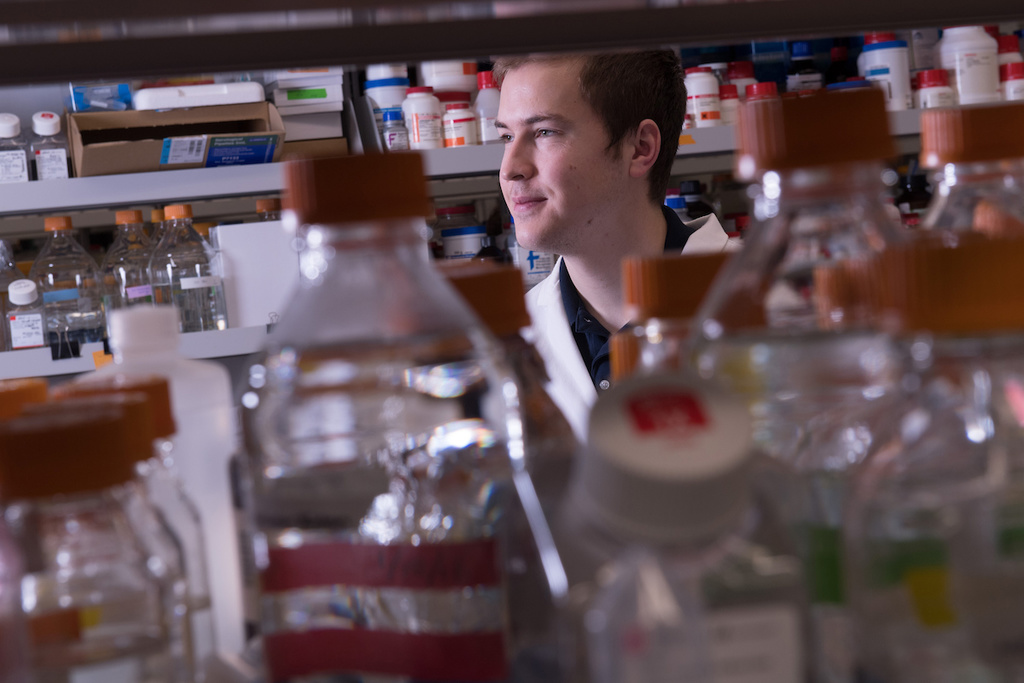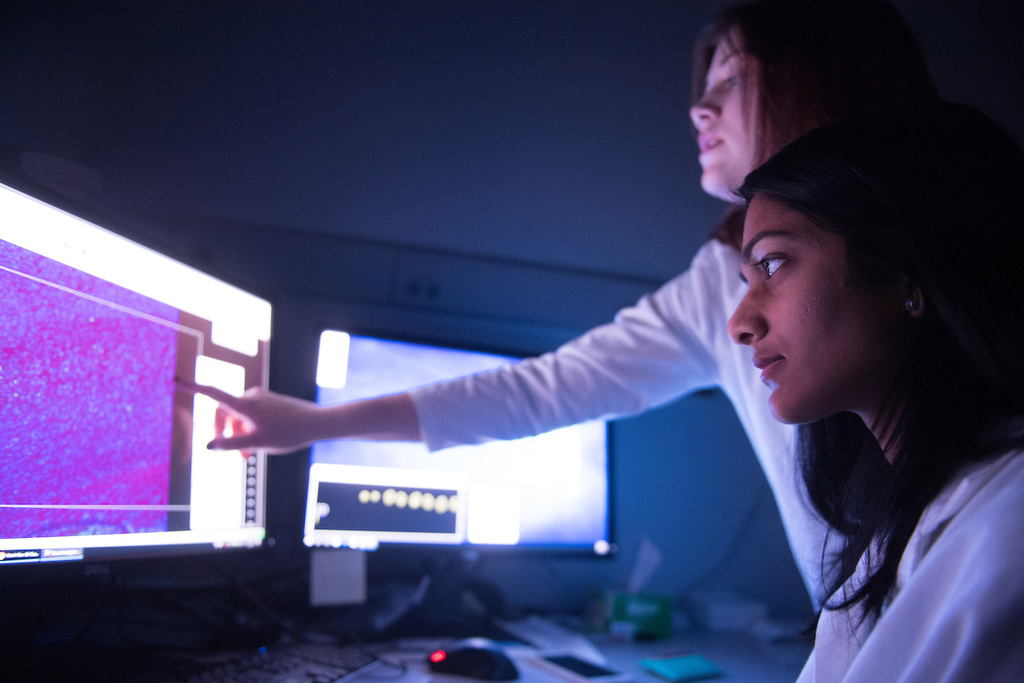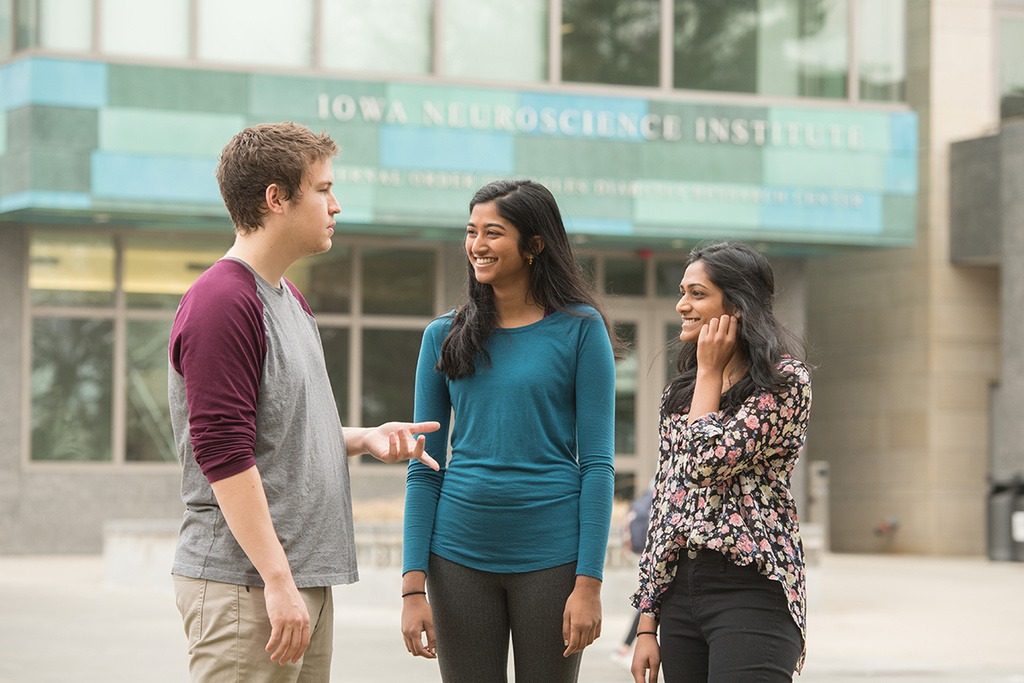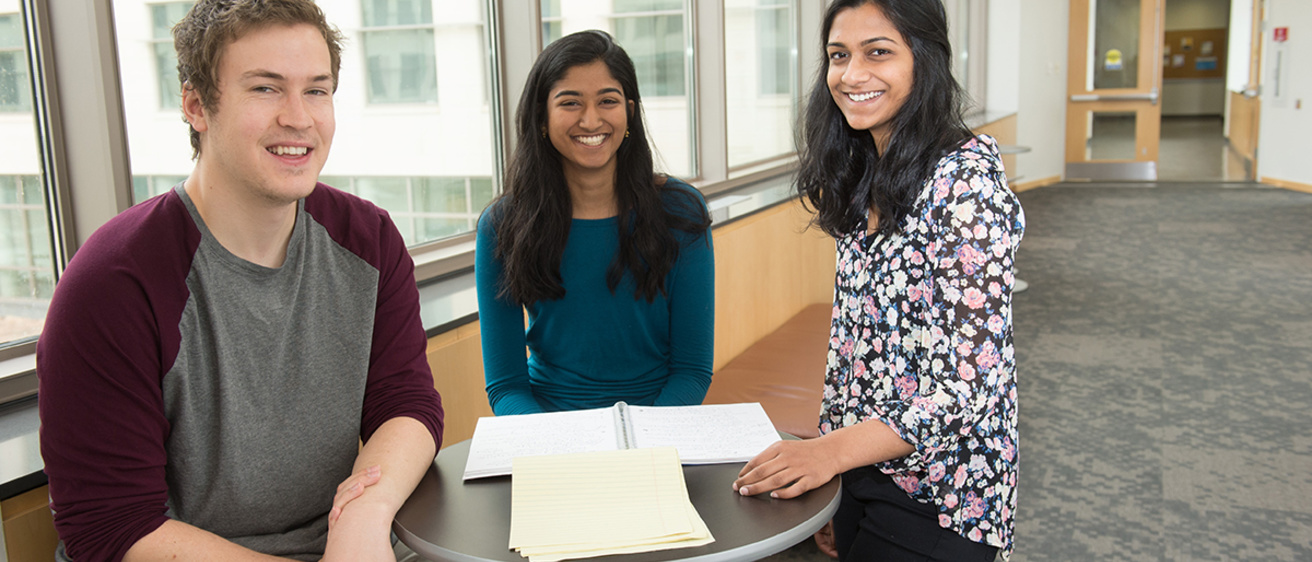Heart disease. Diabetes. Alzheimer’s. Most people reading this know someone affected by one of these serious medical conditions. They take a huge toll on populations across the globe, leading to millions of deaths each year and billions of dollars in health care costs.
Research at Iowa runs the gamut
A common misconception is that research is limited to the sciences. Not true. Research is happening in every University of Iowa department and major, including the arts and humanities and the social sciences.
And because all of the colleges are located on a central campus, it’s possible for a UI student to, for example, study genetic disorders in the Carver College of Medicine while also working on a human rights project in the College of Law. There is a broad range of research opportunities available.
Learn more about getting involved by visiting the Iowa Center for Research by Undergraduates at uiowa.edu/icru.
Researchers at the University of Iowa have been working to end these and related diseases for decades. When the Pappajohn Biomedical Discovery Building (PBDB) opened on campus in 2014, they got a boost: six floors of dedicated lab space and a university commitment to solving the world’s most pressing health care problems.
Leading experts in their field are able to focus on cardiovascular health, diabetes, hearing loss, lung disease, and neurological disorders, and the building layout encourages collaboration and innovation.
These researchers enjoy another asset: undergraduate students. Most hire students to work in their labs. It’s a win-win situation, says Bob Kirby, director of the Iowa Center for Research by Undergraduates. Not only do the investigators appreciate having fresh perspectives on their work, the students involved are more likely to stay in their major, have a higher GPA, and graduate on time. And they may play a role in the next major discovery.
“Being involved in research allows students to take what they have learned in the classroom and apply it to the work they are doing in the lab,” Kirby says. “They are learning how to develop questions and to present to others what they have learned. Those skills are applicable to pretty much any situation they will be in after they graduate.”
Hanna Stevens, an assistant professor of psychiatry, employs as many as eight undergraduates each year in her Psychiatry and Early Neurobiological Development Lab at PBDB. She says their presence gives her lab an edge.
“Undergraduates give us the ability to perform work we couldn’t do without that extra help, and having them around allows other members of the lab an opportunity to teach, which brings their work to a new level,” she says. “The students really make the whole work environment more vibrant, and that makes it a great place for all of us.”
See how research has impacted three undergraduates working in labs at PBDB.

Name: Nicholas “Niko” McCarty
Major: Biochemistry and microbiology (minor in chemistry)
Research: The effect of diabetes on the heart
Nicholas McCarty wasn’t even sure he wanted to go to college, but his parents insisted that he submit a few applications.
Now, the UI senior from Geneva, Illinois, is preparing for graduation and has plans to continue his education with a master’s degree and, eventually, a PhD in biophysics. He learned in March that he was selected for a Fulbright award, which will take him to the United Kingdom.
McCarty credits this scholarly transformation to his experience working on research. Urged by his older brother, a biomedical engineer, to seek campus employment in a lab, McCarty emailed five professors during his first week in Iowa City. With the exception of one who was retiring, they all invited him in to talk about opportunities.
E. Dale Abel, chair of internal medicine in the Carver College of Medicine and director of the Fraternal Order of Eagles Diabetes Research Center, stood out to the young student.
“When I first met with him,” McCarty recalls, “I was petrified. Even though I had prepared by reading several of his papers, I didn’t really know what he was talking about when he referred to insulin signaling and downstream targets. But he was confident, and I was drawn to the way he talked about his research. Plus, the focus of his lab is on cardiac dysfunction in diabetic patients. The heart is an astounding organ, pumping blood day in and day out for your entire life. It is fascinating that the dietary and environmental decisions we make in life impact how well the heart works, and as soon as it stops or a section of it fails, there are serious problems.”
In the Abel Lab, McCarty is probing the role of proteins in the heart, specifically those that work as glucose transporters (they take sugar from the bloodstream into the cells), and trying to pinpoint why that function is partially inhibited in a high-fat diet. He spends up to 30 hours a week in the lab reading research papers and conducting experiments, and hopes to publish his first paper as lead author soon.
McCarty says the lab work has played a major role in his education.
“I’ve learned techniques for designing and conducting an experiment, obviously, but I’ve also learned how to critically analyze things. You have to think for yourself and evaluate what you read and what people say,” he says. “Not only has this experience served me well academically—in labs, you’re on the frontlines of topics you’re learning about in class—it has given me confidence. If I move to another field, I know I’ll have the skills to conduct research.”
Though McCarty would like to be a professor someday, running a lab and working with students, he also has an eye toward business and is earning a Certificate in Entrepreneurial Management through the Tippie College of Business. His aim is to patent ideas that benefit public health.
“I think that one of the big goals of this generation should be to reduce the high cost of pharmaceuticals,” he says. “We can use biochemistry and biophysics and a little genetic engineering to make existing drugs cheaper.”
As a student ambassador for the Iowa Center for Research by Undergraduates, McCarty regularly promotes his passion for research.
“I didn’t think research would shape my entire undergraduate experience, but it’s been the most valuable part of my education,” he says. “I have found that I love problem-solving. It’s something I could do for the rest of my life.”

Name: Velarchana Santhana
Major: Biomedical engineering
Research: The pathology of diabetic retinopathy
Many students interested in research are eager to jump in and make a difference right away.
It’s an honorable desire and one Velarchana Santhana relates to. The UI junior has been a hospital volunteer since high school and plans to become a doctor—the perfect combination of her passions for science and service, she says—and she recalls the enthusiasm she felt her freshman year when she started working with Isabella Grumbach, associate professor of cardiology in the Carver College of Medicine.
But if there is anything she has learned working in a research lab, it’s that scientific discovery takes time. It’s figuring out what the steps in an experiment should be and learning how to perform them—like operating a microscope—and then being patient if things don’t go as expected. Or not getting discouraged when experiments fail, as they sometimes do.
“I didn’t realize how complicated research could be, how much collaboration there is, and how much time it takes,” says Santhana, who studies diabetic retinopathy in partnership with researchers in the Carver College of Medicine and in the Iowa City Veterans Affairs Medical Center. “My project is simple, but it has taken me a year.”

Iowa will prepare you, challenge you, and change you. You will change the world.
From tomorrow’s doctors and engineers, to poets and playwrights, to physicists and entrepreneurs, every single Hawkeye learns how to build their own path and bravely go wherever it leads. Learn more...
After spending her first year in the lab learning basic skills such as pipetting, genotyping, and mouse colony maintenance, Santhana began a project to determine whether using mice as models is useful in studying diabetic retinopathy in humans. People with Type 1 diabetes develop poor vision as the disease progresses due to changes in the retina, but there is debate in the scientific community about what causes these changes. She is still working on comparing the data, but if the pathology of the disease in mice is similar to that in humans, advances may be made in preventing eye damage in diabetic patients.
“I’ve learned so much in the lab—and I love being able to apply that knowledge to my classwork,” says Santhana, who is majoring in biomedical engineering. “Working in the lab has given me a purpose outside school.”
Santhana says she was drawn to the field of medicine at an early age. She grew up in North Liberty, Iowa, just a few miles from the UI campus, and her family had weekly dinners with a friend in the neighborhood who was an electrophysiologist. Conversations at those gatherings coupled with her interest in science inspired her to pursue a career as a doctor.
When it came time to select an undergraduate college, Santhana was adamant about not attending the University of Iowa. She wanted to leave home and applied to schools across the country. In the end, however, she says Iowa offered the best scholarship package—and the only biomedical engineering program in the state.
“I decided to study biomedical engineering in case I didn’t pursue medical school, but I think what I’m learning in class will make me a better doctor someday,” she says. “For example, last semester I took a medical imaging course and now I understand how MRIs and ultrasound work.”
Santhana wants to specialize in pediatrics or ophthalmology. She says the skills she has learned during her 10-hour work weeks in the lab and the regular exposure she has had there to doctors, scientists, and even German exchange students have proven helpful in her coursework and will serve her in her future career.
“I tell students who ask about research to find something they are interested in and pursue it because there are opportunities at Iowa for those who want them,” she says. “Although it takes time to learn different techniques and become proficient at them, research is a great way to get direct access to faculty members.”

Name: Akanksha Chilukuri
Major: Neurobiology (minor in anthropology)
Research: The impact of preeclampsia on the brains and behavior of offspring
Akanksha Chilukuri may be a first-year student at the University of Iowa, but she already is comfortable navigating several health science buildings on campus and operating high-tech lab equipment. She doesn’t hesitate to pause her work freezing tissue in a cryostat to traverse multiple hallways and stairwells to fetch dry ice for a colleague in need.
Shortly after arriving on campus, Chilukuri started working in the lab of Hanna Stevens, assistant professor of psychiatry in the Carver College of Medicine. She is contributing to a project investigating the impact of preeclampsia—a serious condition pregnant women can develop that is marked by high blood pressure—on the brains and behavior of offspring in an animal model. Day-to-day activities can involve dissection, sectioning and staining tissue, and using microscopes.
“We know social behavior is affected by preeclampsia, so we are looking at whether brain physiology is affected,” says Chilukuri, who wants to be a neurologist and conduct research of her own someday.
The Des Moines native knew that as a top-tier research institution the University of Iowa would offer ample opportunities for students to get involved, but she says she has been surprised by how accessible the UI researchers are.
“I enjoy looking at the results and seeing how they fit together, figuring out the cause-effect relationship, and then determining what to do next. This is advanced science.” —Akanksha Chilukuri
“I see my graduate student mentor every day, and I meet with Dr. Stevens weekly. In fact, I feel that she focuses just as much on teaching me as she does on her research,” says Chilukuri, noting that she has friends in her classes who also are working in research labs. “It’s nice to have support away from home. Everyone is really smart, and if I ever need help, someone is here for me.”
Chilukuri says working in a research lab has been fun—and very educational.
“There is so much I can learn here. I enjoy looking at the results and seeing how they fit together, figuring out the cause-effect relationship, and then determining what to do next. This is advanced science. The concepts are intellectually challenging,” she says. “I’ve learned how to make connections between what I read and what I’m doing, and how to think about science.”
In addition to spending 10 hours a week in the lab, Chilukuri is part of Iowa Andhi, a South Indian fusion dance team, and Walk It Out, an annual multicultural fashion show that benefits patients with HIV/AIDS. She also volunteers at the UI Rape Victim Advocacy Program.
“I’ve definitely developed time-management skills,” she says. “I recommend that students give research a try. Every professor at Iowa is doing research of some kind, so it’s not hard to find a project you’re passionate about.”

Story by Sara Epstein Moninger
Photography by Tim Schoon
Video by Clarity Guerra
